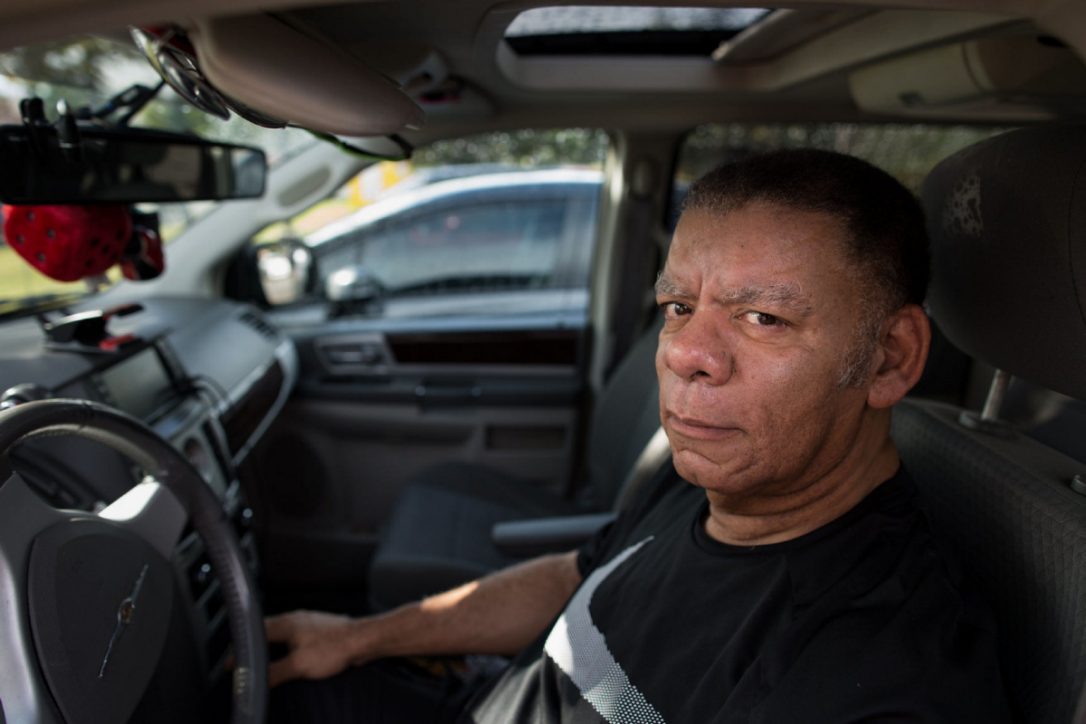Ontario Highway Traffic Act doesn’t define a U-turn, but Michael Robinson was found guilty for disobeying a ‘no U-turn’ sign after doing a three-point turn.

Michael Robinson, who fought a U-turn ticket in court, pictured in his car in a Brampton parking lot. (NICK KOZAK / FOR THE TORONTO STAR)
Brampton resident Michael Robinson realized this in September 2015 when he was on his way to pick up his wife from her job at Wal-Mart, driving north on Sunforest Dr. He turned left into a driveway, reversed his car and proceeded south — a standard three-point turn.
Robinson was pulled over by a Peel Region police officer for disobeying a “No U-turn” sign and given a ticket.
But is a three-point turn also a U-turn? The police say yes, even though the Ontario Highway Traffic Act does not offer a clear definition of a U-turn or a three-point turn.
Robinson disagreed so he fought the ticket in court.
A three-point turn, Robinson argued in court, is a series of manoeuvres, while a U-turn is one continuous motion.
“It does not take rocket science and a higher education to understand the shape of a U in our alphabet,” Robinson told the Star in an interview. “Unfortunately the vagueness and ambiguity within our laws allows different interpretations . . . The goal is about road safety. I believe that I practised very good road manners and safety.”
The officer who pulled him over testified that Robinson did a U-turn because his vehicle did not fully leave the roadway during the three-point turn.
Neither argument was central to the verdict.
On Aug. 18, Robinson was found guilty of disobeying a sign.
Section 143 of the Highway Traffic Act refers to a U-turn as a turn “so as to proceed in the opposite direction,” and that was what led to Robinson’s charge.
Justice of the Peace Richard Quon heard the case and produced a 42-page ruling, which concluded: “A three-point turn as a driving manoeuvre is not defined in the Highway Traffic Act . . . and as such, a three-point turn for the purposes of the Highway Traffic Act is not legally distinct from a U-turn manoeuvre.
“The defendant’s turns and driving manoeuvre . . . constitute a U-turn manoeuvre within the meaning of the Highway Traffic Act, since their purpose had been to facilitate the motor vehicle turning around to proceed in the opposite direction.”
Robinson said he was given two demerit points, but the usual fine of $85 was waived.
The Ministry of Transportation told the Star that Robinson “was charged with changing the direction of travel . . . regardless of the matter in which the change was executed. This type of manoeuvre was prohibited at the location.”
Jordan Donich, a traffic lawyer at Donich Law in Toronto who wasn’t part of the case, told the Star that a driver’s intent to turn around is more important than the manoeuvre itself.
“How ridiculous would it be if all someone would need to get around an illegal U-turn would be to stop two or three times along the way?” Donich asked. “The U-turn is there not necessarily to prevent a U-turn necessarily, it’s because it’s unsafe to make a 180 and proceed the other way . . . it’s not so much about the manner in how you turn.”
Donich said that the absence of a definition of a U-turn is intentional.
“They want to have liberal interpretation of your behaviour. If it’s too clearly defined, people can then create a conduct that may not fit the definition and get off free.”
Daniel Slovak, a paralegal at Traffic Ticket Knights in Markham, also agreed with the ruling.
“He was trying complete something illegal by maneuvering in a different way, he should have been a little bit more creative,” Slovak said. “I would have pulled into the driveway. I would count, one Mississippi, two Mississippi, three Mississippi.”
Robinson is still frustrated by the decision.
“It was based not on constitutional or charter law but a vague common law practice of favouring breach ‘intent of the law,’ ” Robinson said. “Had I the time or funds I would pursue it further.
“In the end the little guy suffers. Those who are unaware just go on paying fines.”
Source: The Toronto Star
